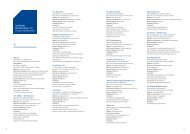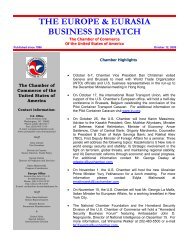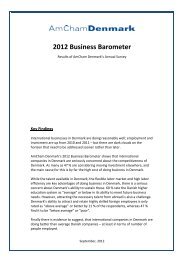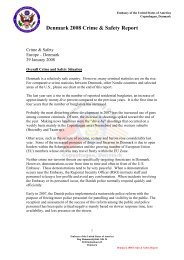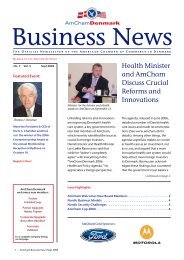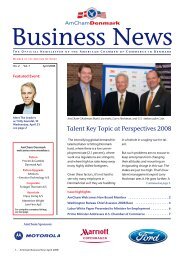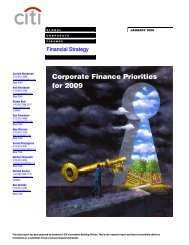Amcham yearbook 2007-Tom5 - American Chamber of Commerce ...
Amcham yearbook 2007-Tom5 - American Chamber of Commerce ...
Amcham yearbook 2007-Tom5 - American Chamber of Commerce ...
You also want an ePaper? Increase the reach of your titles
YUMPU automatically turns print PDFs into web optimized ePapers that Google loves.
If a property is tax-depreciable, the difference<br />
between the written down value and the<br />
sales price is tax-deductible. However, this<br />
loss reduces the purchase price when calculating<br />
the capital gain. Please see above.<br />
Machinery and equipment<br />
The proceeds from sale <strong>of</strong> machinery and<br />
equipment are deducted from the depreciation<br />
pool. Therefore, a taxable capital income<br />
gain or loss does not typically arise when<br />
such assets are sold. If the balance <strong>of</strong> the<br />
depreciation pool becomes negative, the<br />
negative amount may be recognized in the<br />
same year or deferred to the next year,<br />
except if subsequent purchases in that year<br />
exceed the negative amount.<br />
Goodwill<br />
Gains from sale <strong>of</strong> goodwill are treated as<br />
taxable income and losses are deductible.<br />
Know-how, patents<br />
and trade-marks etc.<br />
Capital gains and losses from other intangible<br />
assets such as know-how, trade-marks,<br />
patents and copyrights are also generally<br />
included in the taxable income in the year <strong>of</strong><br />
disposal. The capital gains or losses are calculated<br />
as the difference between the cash<br />
equivalent <strong>of</strong> the written down value for the<br />
tax purposes and sales prices.<br />
Gains and losses from<br />
exchange adjustments<br />
Realized foreign exchange gains and losses<br />
must be included in the taxable income<br />
when realized. Unrealized gains and losses<br />
may, upon application, be included in the<br />
taxable income.<br />
However, if permission has been granted, the<br />
company will not be able to revert to the<br />
ordinary method <strong>of</strong> only including realized<br />
exchange gains and losses.<br />
Deductions<br />
Business expenses<br />
Generally, expenses incurred during the year<br />
in order to “earn, secure and maintain the<br />
income” are fully deductible on an accrual<br />
basis.<br />
Capital expenditure<br />
Generally, capital expenditure is not<br />
deductible. However, acquisitions <strong>of</strong> small<br />
assets representing a value <strong>of</strong> up to DKK<br />
11,300 (2006) / DKK 11,600 (<strong>2007</strong>) or with<br />
a useful life up to three years may be written<br />
<strong>of</strong>f immediately in the year <strong>of</strong> purchase.<br />
Research and development<br />
Research and development costs are upon<br />
the choice <strong>of</strong> the taxpayer either fully taxdeductible<br />
in the year the costs are incurred<br />
or may be amortized in equal installments<br />
over a period <strong>of</strong> five years. For tax purposes<br />
costs relating to the acquisition <strong>of</strong> know-how<br />
and patents can be fully deducted in the year<br />
<strong>of</strong> purchase.<br />
Computer s<strong>of</strong>tware<br />
The costs <strong>of</strong> computer s<strong>of</strong>tware are fully<br />
deductible in the year <strong>of</strong> purchase.<br />
Entertainment expenses<br />
Only 25% <strong>of</strong> business entertainment expenses<br />
are deductible for tax purposes. The definition<br />
<strong>of</strong> entertainment expenses is broad<br />
and includes e.g. gifts to customers. The<br />
rules do not apply to expenses related to<br />
employees <strong>of</strong> a company. Such expenses are<br />
fully tax-deductible. Advertising costs are<br />
also fully tax-deductible.<br />
Provisions for bad debts<br />
Recognized losses on accounts receivable are<br />
deductible. Provisions for bad debts are<br />
deductible to the extent that the final losses<br />
on specified debtors can be substantiated.<br />
Depreciation<br />
Tax depreciation is calculated according to<br />
the following rules, irrespective <strong>of</strong> the<br />
method applied for accounting purposes.<br />
Machinery and equipment<br />
Machinery and equipment are depreciated<br />
collectively on a declining-balance basis. This<br />
balance may be written <strong>of</strong>f at an annual rate<br />
<strong>of</strong> up to 25%.<br />
Machinery and equipment<br />
used for leasing purposes<br />
Assets like machinery, motor vehicles, <strong>of</strong>fice<br />
machines, and <strong>of</strong>fice equipment that are<br />
leased out are generally not depreciable in<br />
the year <strong>of</strong> acquisition, but may be depreciated<br />
at 50% in the following year. However,<br />
exemption may be granted by the Danish tax<br />
authorities, allowing leased assets to be<br />
depreciated according to the general rules<br />
applicable to operating equipment.<br />
Buildings<br />
Buildings used for commercial and industrial<br />
purposes may be depreciated at an annual<br />
rate <strong>of</strong> up to 5% over a period <strong>of</strong> 20 years,<br />
using the straight-line method based on the<br />
purchase price.<br />
Buildings used for the following purposes<br />
are generally not depreciable:<br />
• Offices, unless the building is closely<br />
connected to a depreciable building<br />
• Activities such as banking,<br />
mortgage banking, insurance, etc.<br />
• Postal services<br />
• Residence, except hotels,<br />
camping huts, nursing homes etc.<br />
• Hospitals<br />
Goodwill<br />
Goodwill and other intangible assets<br />
acquired in 1998 or later can be amortized<br />
over a 7-year period. Special rules apply to<br />
goodwill acquired prior to 1998 and goodwill<br />
acquired from affiliated parties.<br />
Leasehold improvements<br />
Leasehold improvements are amortised in<br />
equal amounts over the term <strong>of</strong> the lease if<br />
the term exceeds five years. Otherwise, the<br />
leasehold improvements are generally amortized<br />
over five years at an annual rate <strong>of</strong> 20%.<br />
Inter-company loans<br />
(Thin capitalisation)<br />
A Danish company cannot deduct interest<br />
expenses or capital losses on debt raised with<br />
affiliated parties, including both Danish and<br />
foreign parties, to the extent that the total<br />
debt <strong>of</strong> the company in question exceeds a<br />
debt-to-equity ratio <strong>of</strong> 4:1 at the end <strong>of</strong> the<br />
year.<br />
Limited deductibility applies only to interest<br />
expenses (capital losses) relating to the part<br />
<strong>of</strong> the controlled debt that needs to be converted<br />
to equity to satisfy the debt-to-equity<br />
rate <strong>of</strong> 4:1 (i.e. a minimum <strong>of</strong> 20% equity).<br />
The right to deduct interest (capital losses)<br />
on controlled debt is not restricted if the<br />
company can demonstrate that similar<br />
financing can be obtained between unrelated<br />
parties.<br />
Transfer Pricing<br />
Danish entities are for transfer pricing purposes<br />
required to apply prices and terms in<br />
intra-group transactions that correspond to<br />
such prices and terms as unrelated parties<br />
would apply in comparable transactions.<br />
Such enterprises are required to prepare and<br />
maintain written documentation concerning<br />
the prices and terms applied in the intragroup<br />
transactions. It should be possible, on<br />
the basis <strong>of</strong> such documentation, for the tax<br />
authorities to assess whether the prices and<br />
terms have been fixed in accordance with the<br />
arm’s-length principle. The requirements are<br />
applicable for both domestic and cross border<br />
inter-group transactions.<br />
Joint taxation<br />
Compulsory national taxation<br />
All Danish group companies as well as all permanent<br />
establishments and real properties in<br />
Denmark must be mandatory jointly taxed.<br />
The fiscal unity implies that tax losses<br />
incurred in one entity can be utilized against<br />
taxable pr<strong>of</strong>its realized in another participating<br />
entity. Tax losses incurred prior to the<br />
establishment <strong>of</strong> the fiscal unity cannot be<br />
utilized in other group companies’ taxable<br />
income.<br />
The delimitation <strong>of</strong> which companies are to<br />
be jointly taxed follows the group definition<br />
for financial reporting purposes. An enterprise<br />
is a group enterprise if the parent holds<br />
the majority <strong>of</strong> the voting rights. Thus, the<br />
size <strong>of</strong> the percentage interest is irrelevant. If<br />
all the shares carry identical voting rights, the<br />
enterprises are, basically, subject to joint taxation,<br />
provided that the parent and companies<br />
controlled by the parent own more than<br />
50% <strong>of</strong> the share capital in the subsidiary.<br />
Statement <strong>of</strong> taxable income<br />
The taxable income is made up for each individual<br />
enterprise in accordance with the general<br />
provisions <strong>of</strong> Danish tax law. The entire<br />
income <strong>of</strong> both wholly and partly owned<br />
enterprises is included in the statement.<br />
Special rules apply with respect to tax loss<br />
carry forwards.<br />
Administration Company<br />
The ultimate Danish company in a group is<br />
the administration company.<br />
Liability<br />
The individual jointly taxed companies,<br />
including the administration company, are<br />
liable only for the tax on their own income.<br />
Once the companies have paid their share <strong>of</strong><br />
the tax to the administration company, the<br />
administration company will be liable for the<br />
taxes received from the other jointly taxed<br />
companies.<br />
Foreign permanent<br />
establishments/real properties<br />
Income in a foreign permanent establishment<br />
or real property is not included in the<br />
Danish income, unless international joint taxation<br />
has been elected.<br />
International joint taxation<br />
A Danish company can elect international<br />
joint taxation, in which case all non-Danish<br />
and Danish group enterprises and permanent<br />
establishments/real property must be<br />
part <strong>of</strong> the joint taxation arrangement. This<br />
also applies to foreign parents and sister<br />
companies, if any. The income in the foreign<br />
enterprises and permanent establishments/<br />
real property is made up in accordance with<br />
Danish tax rules, and a credit relief is granted<br />
for tax paid outside Denmark.<br />
The application <strong>of</strong> international<br />
joint taxation is limited.<br />
(Left) The Round Tower, (Right) Windmill Park<br />
56 57<br />
Hans Henrik Tholstrup





